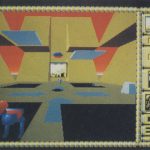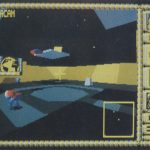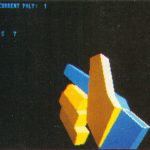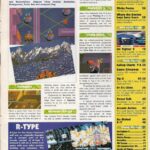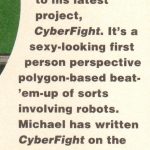1991 Electronic Arts
Platforms: PC and Commodore Amiga
You could say that our next entry was quite ahead of its time when due for release back in 1991. Cyber Fight was to build on the recent success of Street Fighter 2 and produce a fighting game within a 3D environment and first person view, heavily inspired it seems by the 1989 film Robot Jox.

The game’s author (Michael Powell) was no stranger to 3D titles, having previously developed the impressive Powerdrome a few years earlier for Electronic Arts. This time you were the pilot of a large robot within a hi-tech arena, who has to smash your opponent’s droid to pieces.
From winning a match, you get cash to buy upgrades to weapons and armour for your next battle. The aim to simply move your way up the league to become champion. As well as stomping around the arena, you have limited fuel jet packs to hover onto platforms, and can have up to two weapons fitted (one for each arm).
Weapons would consist of chainsaws, clamps, clubs, shotguns, cannons and missiles, and there was to be around six arenas overall. One particular area would have a pool of molten metal that you can drop your opponent into – maybe someone had heard of the scene from Terminator 2 pretty early on? ;-)
One of the many interesting features would be the hidden switches in some of the areas within the floor, where some would turn off the arena’s artificial gravity (forcing robots to fight in zero-G) and others turning off the stadium lighting.
Also during battle, if your arm becomes too damaged – you will lose use of it or it can be completely ripped off. Losing both legs will render you unable to move anywhere – at which point you may want to eject and try and escape back to your re-arming station to jump into another shell (if available).
Planned release platforms
The game was primarily being developed for PC in VGA and MCGA modes, with the game running around 8 frames per second on a 20MHz PC with shading and full detail switched on. There would be later plans to port to the Amiga, with the Gouraud shading techniques likely dropped due to the speed compromises that would need to be made.
Of course, the game would be multiplayer – either via split screen or via a data link and two machines. I’d dread to think how slow the split screen view was, and I suspect the Gouraud shading would have been dropped for that mode.
Overall, the game engine was deemed to be complete at the time of ACE magazines 1991 article, and it was mostly the plot specifics and smaller details that needed ironing out. It was anticipated that the game would see release in early 1992, but it was never to happen for reasons as to which are currently unknown.
As the game seems to have progressed quite far – it sounds promising that something could be found of it to play. Well, at least on PC anyway. We’d be surprised if anything was ever started on the Amiga, though its quite possible that Michael started some kind of technical demo to see what the speed would be like?
Thanks to contributor and developer Glyn Williams, a link was made with a later release on the Super Nintendo called Vortex. This was released in 1994 and developed by Argonaut Software, but crucially Michael was involved on the design of the game. Although it is not exactly the same design as Cyber Fight – the inclusion of the controllable robots we’d guess would have taken some inspirations from his abandoned development.
If you know anything more about this particular development though – please do get in touch. We hope to speak to Michael himself very soon to find out more.
With thanks to Karl Kuras for the heads up, Glyn Williams for the Vortex connection, Stephen Stuttard for the hi-res scans and Ross Sillifant for additional scans.



